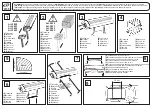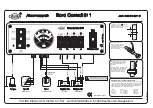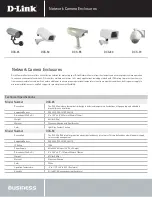
7/16
Connections with Pizzato Elettrica expansion modules (e.g. CS ME-03••••)
(only ST D•5•••• versions)
OS2
OS1
IS2
IS1
A1
+
A2
-
ST D•51•••
EDM
OS2
OS1
Modulo di espansione
EDM
EDM
A2
4.7 Operating states
LEGEND: / = off = indifferent
5-pole versions
PWR
LED
OUT
LED
IN
LED
ACT
LED
Sensor
state
Description
/
/
/
/
OFF
Sensor off.
orange
/
/
/
POWER
ON
Internal tests upon activation.
green
/
/
/
RUN
For ST D•2•••• versions
Actuator outside safety activation area. Safety
outputs off. O3 output off.
green
/
/
green
RUN
For ST D•6•••• versions
Actuator outside safety activation area. Safety
outputs off. O3 output active.
green
green
/
green
RUN
For ST D•2•••• versions. Safety outputs active.
Actuator in safe area. O3 output active.
green
green
/
/
RUN
For ST D•6•••• versions. Safety outputs active.
Actuator in safe area. O3 output off.
green
green
/
blinking
green/
orange
RUN
For ST D•2•••• versions
Actuator in limit activation zone. O3 output
active. Recommended action: bring the sensor
back to the safe area.
green
green
/
blinking
orange
RUN
For ST D•6•••• versions
Actuator in limit activation zone. O3 output off.
Recommended action: bring the sensor back
to the safe area.
green
blinking
red
/
ERROR
Error on outputs.
Recommended action: check for any short
circuits between the outputs, outputs and
ground or outputs and power supply, then
restart the sensor.
red
/
ERROR
Internal error.
Recommended action: restart the sensor. If
the failure persists, replace the sensor.
8-pole versions
PWR
LED
OUT
LED
IN
LED
ACT
LED
Sensor
state
Description
/
/
/
/
OFF
Sensor off.
orange
/
/
/
POWER
ON
Internal tests upon activation.
green
/
/
RUN
Sensor with inactive inputs and safety outputs
off.
green
/
/
/
RUN
For ST D•3••••, ST D•4•••• e ST D•5••••
versions
Sensor with inactive inputs, actuator outside
safety activation area. Safety outputs off. O3
output off.
green
/
/
green
RUN
For ST D•7•••• e ST D•8•••• versions
Sensor with inactive inputs, actuator outside
safety activation area. Safety outputs off. O3
output active.
green
green
RUN
Activation of the inputs.
green
/
blinking
green/
orange
RUN
Input incoherence.
Recommended action: check for presence
and/or wiring of inputs.
green
green
RUN
For ST D•3••••, ST D•4•••• e ST D•5••••
versions
Actuator in safe area.
O3 signalling output active.
green
/
RUN
For ST D•7•••• e ST D•8•••• versions
Actuator in safe area.
O3 signalling output off.
green
blinking
green/
orange
RUN
For ST D•3••••, ST D•4•••• e ST D•5••••
versions
Actuator in limit activation zone, O3 active.
Recommended action: bring the sensor back
to the safe area.
green
blinking
orange
RUN
For ST D•7•••• e ST D•8•••• versions
Actuator in limit activation zone, O3 off.
Recommended action: bring the sensor back
to the safe area.
green
green
green
green
RUN
For ST D•3••••, ST D•4•••• e ST D•5••••
versions
Activation of the inputs. Actuator in safe area
and safety outputs active.
green
green
green
/
RUN
For ST D•7•••• e ST D•8•••• versions
Activation of the inputs. Actuator in safe area
and safety outputs active.
green
blinking
red
ERROR
Error on outputs.
Recommended action: check for any short
circuits between the outputs, outputs and
ground or outputs and power supply, then
restart the sensor.
red
ERROR
Internal error.
Recommended action: restart the sensor. If the
failure persists, replace the sensor.
green
blinking
red
ERROR
For ST D•5•••• versions
Error detected by EDM input.
Recommended action:
Check the functioning of the contactors and/or
their switching times.
4.8 Programming rules (ST D•4•••• and ST D•8•••• versions only)
The programmable version is equipped with a dedicated input to enable programming of the sensor
so that it recognises the code contained in a new actuator. This operation is repeatable an unlimited
number of times. After programming has been completed, the sensor will recognise only the actuator
code corresponding to the last executed programming operation.
Attention: The machine manufacturer must allow access to the sensor programming mode
only for suitably trained individuals.
•
Observe all the general warning points.
•
Observe the warnings given in the section INSTALLATION AND CONNECTION INSTRUCTIONS.
•
Once the operation is carried out, check recognition of the newly programmed actuator and the
sensor operation.
4.9 Programming procedure
•
Power the sensor at the rated voltage. The sensor carries out internal tests (1).
•
The programming operation can be carried out either with the safety inputs deactivated (2) or with
the safety inputs activated (3).
•
Activate the I3 programming input by applying the voltage U
e1
. The IN LED starts to flash orange
to indicate the wait for the new code to be memorised (4).
•
Position the new actuator on the sensor so that the centring symbols are aligned. When program-
ming is complete the ACT LED emits four green flashes (5).
•
Programming has been completed successfully when the ACT LED goes out (6). Now deactivate
the programming input I3.
•
The sensor restarts automatically and repeats the internal tests (7) in order to be able to switch to
the "RUN" state.
PWR
LED
OUT
LED
IN
LED
ACT
LED
Sensor
state
Description
orange
/
/
/
POWER
ON (1)
Internal tests upon activation
green
/
/
/
RUN (2)
Sensor awaiting inputs
green
/
green
/
RUN (3)
Inputs present, awaiting actuator
green
/
blinking
orange
/
PROGRAM-
MING (4)
Programming input active, awaiting new
actuator for programming
green
/
orange
blinking
green
x 4
PROGRAM-
MING (5)
Programming input active. New code
successfully memorised
green
/
orange
/
PROGRAM-
MING (6)
Programming input active. Programming
finished.
orange
/
/
/
POWER
ON (7)
Automatic restart and internal tests
5 INSTRUCTIONS FOR PROPER USE OF THE DEVICE
5.1 Installation
Attention: Installation must be carried out by qualified staff only.
• Power the sensor and the other safety devices connected to it from a single, safely isolated PELV
or SELV source compliant with applicable standards.
• The safety sensor should be powered using a source different from the one used for the equipment.
• Observe the assured operating (
S
ao
) and release (S
ar
) distances.
• Adjustments should be carried out referring to the diagram shown in the actuation distances
section.
• Do not deform or modify the device for any reason.
• Do not exceed the tightening torques specified in the present manual.
• The device carries out an operator protection function. Any inadequate installation or tampering
can cause people serious injuries and even death.
• These devices must not be bypassed, removed, turned or disabled in any other way.
• If the machine where the device is installed is used for a purpose other than that specified by the
producer, the device may not provide the operator with efficient protection.
• Before commissioning the machine, and periodically, check for correct switching of the outputs and
correct operation of the system comprising the device and associated safety circuit.
• The safety category of the system comprising the safety sensor also depends on external devices
and their connection.
• Before installation, make sure the device is not damaged in any part.
• Before installation, ensure that the connection cables are not powered.
• Avoid excessive bending of connection cables in order to prevent any short circuits or power
failures.
• Do not paint or varnish the device.
• Do not use the device as a support or rest for other structures, such as raceways, sliding guides
or similar.
• Before commissioning, make sure that the entire machine or system complies with all applicable
standards and EMC directive requirements.
• The switch fitting surface must always be smooth and clean.
• The documents necessary for a correct installation and maintenance are always available in the
following languages: English, French, German and Italian.
• Should the installer be unable to fully understand the documents, the product must not be installed
and the necessary assistance may be requested (see paragraph 9).
• During and after the installation do not pull the electrical cables connected to the device.
• In proximity of the sensor do not carry out arc welding, plasma welding, or any other process
that may generate electromagnetic fields of intensity higher than the limits prescribed by the
standards, even when the sensor is off.
Should it be necessary to carry out weldings close to a sensor previously installed, it will be
necessary to first remove it.
• Always attach the following instructions to the manual of the machine in which the device is
installed.
• These operating instructions must be kept available for consultation at any time and for the whole
period of use of the device.
5.2 Do not use in the following environments
• Do not use in environments where the application causes the device to be subjected to strong
impacts or vibrations.
• Do not use in environments where explosive or flammable gases are present.
• Do not use in environments where ice can form on the device.
• Do not use in environments containing strongly aggressive chemicals, where the products used
coming into contact with the device may impair its physical or functional integrity.
5.3 Mechanical stop
• The door must always be provided with an independent end-limit mechanical stop at limit of travel.
All this to protect the device from being knocked when the door is slammed hard.
• Do not use the sensor as a mechanical stop for the door according to EN ISO 14119.
5.4 Shock, vibrations and wear
• In case of damages or wear it is necessary to change the whole device.
• Avoid any impact with the device. Excessive shock and vibrations may affect the correct operation
of the device.
• The actuator must not strike the sensor.
©
2016
Cop
yr
ight Pizzato Elettr
ica - tr
anslation of the or
iginal instr
uctions


































